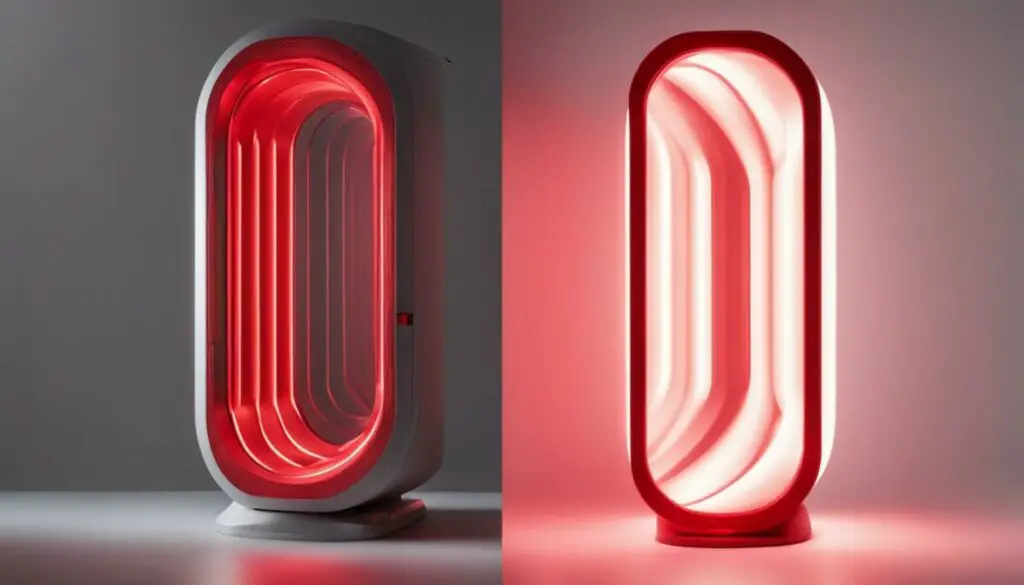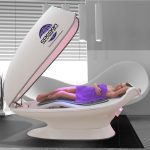Last Updated on 3 months by Francis
In the realm of health and wellness, there are numerous therapies and trends that claim to provide a variety of benefits. Two popular forms of heat therapy that have garnered attention are the infrared sauna and red light therapy. While these practices may seem similar, it is essential to understand their unique qualities and how they can contribute to your overall well-being and natural healing.
Contents
Key Takeaways:
- Infrared saunas and red light therapy are both forms of heat therapy that offer various benefits.
- Infrared saunas use infrared heaters to directly heat the body, promoting relaxation, improved circulation, and detoxification.
- Red light therapy involves exposure to low-level red light wavelengths, which can stimulate cellular repair and improve skin health.
- While there are similarities, infrared saunas and red light therapy differ in terms of the light spectrum, specific health benefits, and target areas.
- Some wellness centers offer a combination of both therapies for enhanced benefits and overall wellness.
Understanding Infrared Sauna Therapy

Let’s start by understanding what an infrared sauna is and its benefits. Infrared saunas use infrared heaters to emit infrared light, which heats the body directly rather than heating the air around you. This form of heat therapy promotes relaxation, improves circulation, detoxifies the body, and may provide other health benefits.
When you step into an infrared sauna, the infrared light penetrates your skin, warming your body from within. Unlike traditional saunas that heat the air, infrared saunas create a gentle and soothing heat that deeply penetrates your tissues and muscles.
The gentle heat generated by an infrared sauna can help you relax and unwind after a long day. It can also provide relief from muscle tension and soreness, making it a popular choice for athletes and individuals seeking natural pain relief.
Beyond relaxation and pain relief, infrared saunas are known to have various benefits for your overall well-being. Improved circulation is one of them. As your body absorbs the infrared light, your blood vessels dilate, increasing blood flow throughout your body. This enhanced circulation can help deliver more oxygen and nutrients to your muscles, tissues, and organs.
Additionally, infrared saunas are believed to aid in detoxification. When you sweat in an infrared sauna, your body releases toxins and impurities through the skin. This gentle detox process can help cleanse your body and support your overall health.
Some other potential benefits of infrared sauna therapy include:
- Reduced stress levels
- Improved skin health
- Enhanced immune function
- Weight loss support
Whether you’re looking to relax, detoxify, relieve muscle tension, or support your overall well-being, infrared sauna therapy can be a valuable addition to your wellness routine. The unique benefits it offers make it an appealing option for those seeking natural healing and relaxation.
Unveiling Red Light Therapy

Moving on to red light therapy, it involves exposure to low-level red light wavelengths that penetrate the skin. This therapy is believed to stimulate cellular repair, improve skin health, reduce inflammation, and enhance natural healing processes in the body.
Red light therapy has gained popularity for its wide range of benefits in various areas of health and wellness. By leveraging the power of red light wavelengths, this therapy can provide natural healing and revitalization.
One of the key benefits of red light therapy is its ability to stimulate cellular repair. The low-level red light wavelengths penetrate the skin and reach the mitochondria, which are responsible for producing energy within cells. This process enhances cellular function and promotes the repair and regeneration of damaged tissues.
Moreover, red light therapy is known to have positive effects on skin health. It can help improve the appearance of the skin by reducing the signs of aging, such as fine lines, wrinkles, and age spots. The therapy stimulates collagen production, which improves skin elasticity and firmness.
In addition to its skin benefits, red light therapy has been found to reduce inflammation in targeted areas. It can be particularly beneficial for individuals dealing with conditions like arthritis or sports-related injuries. By reducing inflammation, red light therapy can help alleviate pain and promote faster healing.
Furthermore, red light therapy enhances the natural healing processes in the body. It stimulates the production of adenosine triphosphate (ATP), which is the energy currency of cells. Increased ATP levels provide the necessary energy for cells to function optimally, leading to improved tissue repair and overall healing.
“Red light therapy has shown promising results in promoting wound healing, reducing acne, and even improving symptoms of certain skin conditions like psoriasis.”
| Benefits of Red Light Therapy |
|---|
| Stimulates cellular repair |
| Improves skin health |
| Reduces inflammation |
| Enhances natural healing processes |
Unique Benefits of Infrared Sauna Therapy

While both infrared sauna and red light therapy offer numerous health benefits, infrared sauna therapy boasts its own unique advantages. Beyond providing relaxation, infrared saunas have been found to contribute to detoxification, pain relief, improved cardiovascular health, weight loss, and stress reduction.
Infrared saunas utilize infrared heaters to emit infrared light, which directly heats the body, rather than the air around it. This focused heat penetrates the tissues and induces a deep sweating effect, aiding in the detoxification process by eliminating toxins and impurities from the body.
Moreover, the gentle warmth of infrared saunas can provide pain relief for individuals suffering from conditions such as arthritis, muscle soreness, and joint stiffness. The heat promotes blood circulation, relaxes muscles, and alleviates discomfort.
Studies have also shown that regular use of infrared saunas can have a positive impact on cardiovascular health. The heat exposure causes the heart rate to increase, mimicking the benefits of moderate exercise, resulting in improved cardiovascular function and circulation.
In addition to its effects on detoxification and cardiovascular health, infrared sauna therapy can contribute to weight loss. The increased heart rate during the sauna session leads to calorie burning and can aid in achieving weight management goals.
Last but not least, infrared saunas provide a peaceful environment that promotes stress reduction and relaxation. The soothing warmth helps to release tension and calm the mind, offering a tranquil escape from the pressures of daily life.
To summarize, infrared sauna therapy offers an array of unique benefits, including detoxification, pain relief, improved cardiovascular health, weight loss, and stress reduction. Incorporating regular infrared sauna sessions into your wellness routine can contribute to a healthier, more balanced lifestyle.
Detoxification, pain relief, improved cardiovascular health, weight loss, and stress reduction are among the unique benefits of infrared sauna therapy.
Unique Benefits of Red Light Therapy

When it comes to skincare, red light therapy offers a range of unique benefits that can improve your skin health and combat the signs of aging. This non-invasive treatment utilizes low-level red light wavelengths to penetrate the skin and stimulate natural healing processes. Let’s explore the specific advantages of red light therapy:
1. Improved Skin Health
Red light therapy promotes healthier skin by increasing collagen production, which is essential for maintaining elasticity and reducing the appearance of wrinkles and fine lines. The red light stimulates fibroblasts, cells responsible for collagen production, resulting in smoother and more vibrant skin.
2. Reduces Signs of Aging
By increasing collagen synthesis and promoting cellular repair, red light therapy can effectively reduce the visible signs of aging. It helps minimize wrinkles, crow’s feet, and age spots, giving your skin a more youthful and rejuvenated appearance.
3. Accelerates Wound Healing
If you’re looking to speed up the healing process of wounds, red light therapy can be beneficial. It boosts blood circulation, enhances tissue repair, and reduces inflammation, leading to faster healing and reduced scarring.
4. Enhances Skin Tone and Texture
Red light therapy can help improve the overall tone and texture of your skin. It promotes a smoother complexion, minimizes pores, and reduces redness and skin discoloration, giving you a more even and radiant skin tone.
5. Aids in Acne and Psoriasis Treatment
For those struggling with acne or psoriasis, red light therapy can offer relief. It helps reduce inflammation, kills bacteria responsible for acne breakouts, and soothes irritated skin. In the case of psoriasis, red light therapy can alleviate symptoms and promote healing of affected areas.
Incorporating red light therapy into your skincare routine can provide a range of benefits, from improving skin health and reducing signs of aging to accelerating wound healing and targeting specific skin conditions. Its non-invasive nature and ability to stimulate natural healing processes make it a popular choice for individuals seeking effective skincare solutions.
Differences Between Infrared Sauna and Red Light Therapy

Although there are similarities, infrared sauna and red light therapy have distinct differences. The key dissimilarity lies in the type of light used—red light therapy concentrates on narrow wavelength ranges, while infrared sauna uses a broader spectrum. The two therapies also target different areas of the body and have varying effects on cellular processes.
Light Spectrum
Red light therapy focuses on specific narrow wavelength ranges, typically around 630-700 nanometers, which are known to penetrate the skin and stimulate cellular repair. Infrared sauna, on the other hand, uses a broader spectrum of infrared light, encompassing wavelengths of 700-3000 nanometers.
Targeted Areas
Red light therapy primarily targets the skin and subcutaneous tissues, delivering light energy directly to these areas. The therapy is commonly used for skin health, anti-aging, wound healing, and other dermatological purposes. In contrast, infrared sauna therapy aims to heat the entire body evenly, with the heat penetrating deep into muscle tissues, promoting relaxation, detoxification, and pain relief throughout the body.
Effects on Cellular Processes
While both therapies have positive effects on cellular processes, they differ in their mechanisms and outcomes. Red light therapy stimulates cellular repair and enhances natural healing processes in the body, including collagen production and DNA synthesis. Infrared sauna therapy, on the other hand, increases blood flow and circulation, promoting detoxification, pain relief, and improved cardiovascular health.
Infrared sauna and red light therapy offer distinct benefits, but their differences highlight the importance of choosing the right therapy based on individual goals and requirements.
| Aspect | Infrared Sauna | Red Light Therapy |
|---|---|---|
| Light Spectrum | Broader spectrum of infrared light | Narrow wavelength ranges, typically in the red light spectrum |
| Targeted Areas | Heat the entire body evenly | Focus on skin and subcutaneous tissues |
| Effects on Cellular Processes | Improves circulation, detoxification, and pain relief | Stimulates cellular repair and enhances natural healing |
Understanding the differences between infrared sauna and red light therapy allows individuals to make an informed decision about which therapy aligns best with their specific wellness goals and requirements. Consulting with a healthcare professional or wellness expert can provide valuable guidance in choosing the right therapy for optimal health and well-being.
Exploring Combined Benefits

For individuals seeking enhanced benefits and a holistic approach to wellness, some wellness centers offer a combination of infrared sauna and red light therapy. By combining these two powerful therapies, individuals can experience the unique advantages of both simultaneously, promoting overall wellness and rejuvenation.
The infrared sauna’s heat therapy helps relax the body, improve circulation, and aid in detoxification. On the other hand, red light therapy stimulates cellular repair, enhances natural healing, and promotes skin health. By combining these therapies, individuals can enjoy the relaxing and detoxifying benefits of the infrared sauna while reaping the skin-rejuvenating and healing effects of red light therapy.
This combination therapy offers a synergistic effect, allowing individuals to optimize the benefits of both modalities. The deep heat from the infrared sauna prepares the body for red light therapy, promoting greater absorption of light and enhancing its therapeutic effects. This comprehensive approach to wellness can contribute to improved overall health, relaxation, and rejuvenation.
“The combination of infrared sauna and red light therapy provides a holistic and integrated approach to wellness. By leveraging the unique benefits of each therapy, individuals can experience a comprehensive rejuvenation that addresses both physical and skin-related concerns.”
Choosing the Right Therapy for You
To determine which therapy, infrared sauna or red light therapy, is right for you, it’s important to consider your health goals and objectives. Each therapy offers unique benefits that can contribute to your overall wellness and health.
Consulting with a healthcare professional or wellness expert can provide valuable insights into how each therapy can align with your specific needs and preferences. They can assess your current health condition, discuss any underlying health issues, and determine the most suitable therapy for you.
Whether you’re seeking relaxation, detoxification, pain relief, improved skin health, or natural healing, an expert can guide you in making an informed decision.
Remember, everyone’s wellness journey is unique, and what works for someone else may not necessarily work for you. By seeking professional advice, you can ensure that your chosen therapy aligns with your goals, maximizes benefits, and enhances your overall well-being.
“Consulting with a healthcare professional or wellness expert is crucial when choosing the right therapy for you. They can provide personalized guidance based on your health goals and objectives.”
Make an informed decision, embrace the therapy that resonates with you, and embark on a journey towards improved well-being and optimal health.
Conclusion
In conclusion, both infrared sauna therapy and red light therapy offer numerous benefits for overall well-being and natural healing. While they share some similarities as forms of heat therapy, it’s important to note their differences in terms of light spectrum, targeted areas, and specific health benefits.
With infrared sauna therapy, the body is heated directly using infrared light, promoting relaxation, improved circulation, detoxification, pain relief, cardiovascular health, stress reduction, and even weight loss. On the other hand, red light therapy focuses on specific skin-related benefits, such as improving skin health, reducing signs of aging, enhancing collagen production, and accelerating wound healing.
Both therapies have their unique advantages and can be used individually or in combination depending on your health goals and objectives. Consulting with healthcare professionals or wellness experts can help determine the best approach for your personal wellness journey. Whether you choose infrared sauna therapy, red light therapy, or a combination of both, these therapies can contribute to your overall well-being and natural healing in a variety of ways.
FAQ
Is an infrared sauna the same as red light therapy?
No, they are different forms of heat therapy with unique benefits and mechanisms of action.
What is an infrared sauna?
An infrared sauna uses infrared heaters to emit infrared light, which directly heats the body to promote relaxation, improve circulation, and provide other health benefits.
What is red light therapy?
Red light therapy involves exposure to low-level red light wavelengths that penetrate the skin to stimulate cellular repair, improve skin health, and enhance natural healing processes in the body.
What are the unique benefits of infrared sauna therapy?
In addition to relaxation, infrared sauna therapy aids in detoxification, pain relief, improved cardiovascular health, weight loss, and stress reduction.
What are the unique benefits of red light therapy?
Red light therapy focuses on skin-related benefits such as improved skin health, reduced signs of aging, enhanced collagen production, accelerated wound healing, and relief from conditions like acne and psoriasis.
What are the differences between infrared sauna and red light therapy?
The key differences lie in the type of light used, targeted areas of the body, and effects on cellular processes. Red light therapy concentrates on narrow wavelength ranges, while infrared sauna uses a broader spectrum.
Can I combine infrared sauna and red light therapy for enhanced benefits?
Yes, some wellness centers offer a combination of both therapies to promote overall wellness and rejuvenation.
How do I choose the right therapy for me?
Consider your health goals and consult with a healthcare professional or wellness expert to determine which therapy aligns with your needs and preferences.
What is the conclusion regarding infrared sauna and red light therapy?
While both therapies offer heat therapy and wellness benefits, they differ in terms of light spectrum, targeted areas, and specific health benefits. Each therapy has its unique advantages and can be used individually or in combination for overall well-being and natural healing.








